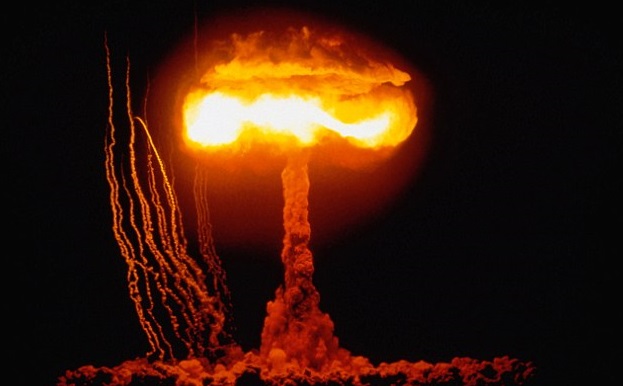
Point, Counter-Point:
Counting Nukes – numerical parity essential for nuclear deterrence?
Earlier in this series:
Point: Nuclear Parity a Necessity for Nuclear Deterrence – a case study of Pakistan and India
Counter-Point: numerical parity is not essential for nuclear deterrence
***
The latest SIPRI figures show that as of early 2014, the nine nuclear weapon states (NWS) possessed approximately 16,350 nuclear weapons, as compared to 17,270 nuclear weapons in early 2013. The United States and Russia hold 93% of total global nuclear stockpiles and both countries have undertaken much of these reductions. Under the New START Treaty, the U.S. and Russia have agreed to limit their deployed nuclear warheads to not more than 1,550 by February 5, 2018. According to the Arms Control Association, the two nuclear weapon states still have a total of 3,285 deployed strategic nuclear-warheads. Interestingly, the reduction trend set by the first-tier NWS has not been followed up by the remaining nuclear-armed states. Why? Perhaps the answer to this is not very difficult. As a legacy of the Cold War, the U.S. and Russia inherited thousands of nuclear weapons that do not strengthen their deterrence capability anymore than what it is presently. Hence, given the vast arsenal of nuclear weapons, it is easier for both the U.S. and Russia to reduce their nuclear inventories from higher-ends of five-figures to modest four-figures without degrading their second-strike capability.
Post-Cold War, the present nuclear order has inherited a complex web of nuclear equations that deeply influence nuclear relationships. The situation has become more complex with the challenges of military modernizations and new military technologies (ballistic missile defence, high-precision non-nuclear weapons, cyber weapons), pre-emptive strategies and military-alliances that critically transform the rationale of nuclear deterrence. The further introduction of tactical nuclear weapons (TNWs) into this complex mix has further heightened strategic uncertainties. This is evident in the U.S.-Russia nuclear relationship. In spite of undertaking major reductions in deployed nuclear weapons, there is a reigning deadlock between Washington and Moscow on tactical nuclear weapons (TNWs). For Russia, TNWs constitute a strategic asset and they will not enter into any arms control negotiations with the U.S. over their strategic assets unless Washington withdraws its forward-deployed TNWs from Europe . The Russian logic is clear – there has to be parity even in mutual nuclear reductions.
Coming to South Asia, unlike U.S.-Russia, the strategic equations are very different amongst the nuclear powers (China, India and Pakistan) in the region. None of these nations have or inherited large, Cold War-like inventories of nuclear weapons. All these nuclear powers are believed to have moderate nuclear arsenals. China has approximately 200-300 warheads, India has produced 90–110 nuclear warheads, and Pakistan reportedly has a stockpile of 100–120 nuclear warheads. Given these moderate numbers, it is practicably difficult for these nations to reduce their nuclear weapons. Geopolitical challenges faced by each of these nuclear nations restrain them from lowering their nuclear warheads. Though China has a deterrent relationship with the United States and Russia, it is also geographically entangled with India. Notably, unlike the other two NWS, China has not engaged in any nuclear weapons reduction trend. On the contrary, China continues to pursue a long-term military modernization and force development that multiplies the formidability of their weapon systems and enhances its strategic primacy. Meanwhile, according to the International Panel on Fissile Materials, Pakistan continues to build highly enriched uranium (HEU), indicating that it is engaged in expanding its fissile material stockpile for its nuclear weapons programme. With China engaged in vigorous military modernization and Pakistan reportedly increasing its fissile material stockpile, it leaves very little or no incentive for India to reduce the number of its warheads.
At present, India and China have stable relations, but there is enough frostiness in their bilateral equation, making them wary of each other. Bilateral India-Pakistan relations have not improvedsince the cancellation of the foreign secretary-level talks in August 2014. Given the existing frigidity in the neighbourhood, India would be cautious about any strengthening of any Sino-Pakistan strategic alliance against India. Any such development could raise the stakes for India and disturb strategic stability in the region. This could be a definite dampener for India to embark upon any unilateral reduction of its strategic assets.
Existing geopolitical entanglements prevent India, Pakistan, or China from entering into any unilateral reduction process – furthermore, they also limit prospects for joint reductions. China’s existing strategic concerns vis-a-vis the United States and Russia requires Beijing to continue its military modernization programme and constrains it from reducing its nuclear warheads. The same logic is apparent in the case of India vis-a-vis China and Pakistan vis-a-vis India.
Continued reliance on nuclear weapons obstructs any reduction process and simultaneously enhances the importance of nuclear parity. The introduction of high-level weapons systems and military strategies has complicated issues of nuclear deterrence and strategic-stability. Technological sophistication, in the form of advanced and high yield precision-guided conventional weapons, has intensified deterrence capabilities. In such circumstances, strategic stability might be endangered if China, India and Pakistan fail to keep its deterrence effective and capable. What is required is a consensus among the regional powers for a multilateral nuclear weapons reduction process. This has to be supported by the remaining P5 countries (U.S., Russia, United Kingdom and France) to affect mutual assured stability both regionally and globally. Until then, it is essential to maintain nuclear parity to prevent deterrence failure and to ensure strategic stability at any level.
***
Image: Stocktrek Images, Getty